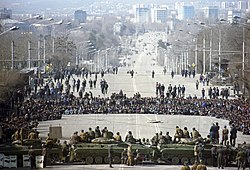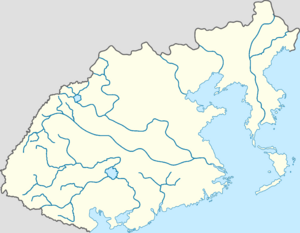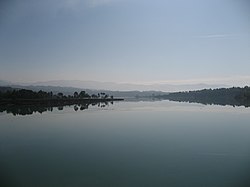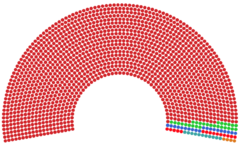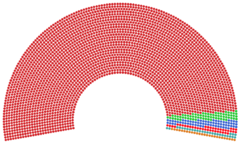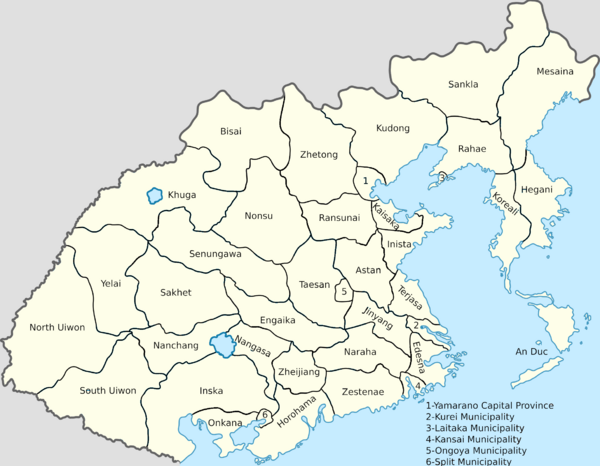Zapote
This article is incomplete because it is pending further input from participants, or it is a work-in-progress by one author. Please comment on this article's talk page to share your input, comments and questions. Note: To contribute to this article, you may need to seek help from the author(s) of this page. |
People's Democratic Republic of Zapote Cộng Hòa Dân chủ Nhân Dân Sapôchê | |
|---|---|
|
Flag | |
| Motto: "Con đường của Kung" "The Way of the Kung" | |
| Anthem: Mặt trời đỏ của Sapôchê (The Red Sun of Zapote) | |
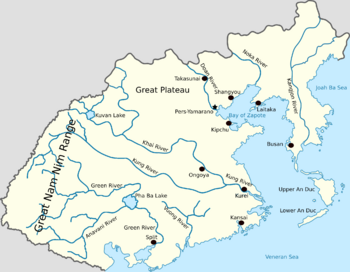 | |
| Capital | Pers |
| Largest city | Yamarano |
| Recognised national languages | Zapoten |
| Ethnic groups | Zapotens 80% Others 20% |
| Demonym(s) | Zapoten |
| Government | Unitary Socialist one-party republic |
• Premier | Sun Sao |
• President of the National Congress | Hoàng Minh Tu |
• Secretary of the Party | Trần Ðức Hu |
| Legislature | National Congress |
| National People's Senate | |
| National People's Commune | |
| Establishment | |
• Establishment of the Zapoten First Empire | 190 B.C.E. |
• Establishment of the Zapoten Republic | 1905 |
• Establishment of the Zapoten Federal Republic | 1920 |
• Establishment of the Zapoten People's Democratic Republic | 1931 |
• New Constitution | 1990 |
| Population | |
• 2020 estimate | |
• 2015 census | |
| GDP (PPP) | 2019 estimate |
• Total | |
• Per capita | |
| GDP (nominal) | 2017 estimate |
• Total | |
• Per capita | |
| HDI (2020) | PeePeePooPoo Error: Invalid HDI value |
| Currency | Zapoten Dong (ZD) |
| Date format | dd-mm-yyyy |
| Driving side | right |
| Internet TLD | .ZP |
Zapote (Zapoten:Sapôchê) officially the People's Democratic Republic of Zapote Zapoten:Cộng Hòa Dân chủ Nhân Dân Sapôchê) is a sovereign state in eastern Vastasia bordering the Venerian Sea. It is the world's most populous country, with a population of around 1.52 billion in 2020. As a one-party state led by the Zapote Revolutionary Communist Party (ZRCP), the country is officially divided into 31 provinces, 6 municipalities, and 3 autonomous regions.
Ethymology
History
First Civil War
Following the western expedition, and the forceful opening of the Talian Dynasty to outsiders, a merchant class established itself to trade with foreigners. Although these merchants suffered backlash for their apparent openness to interact with foreigners, they increasingly became wealthy and held a near monopoly on what little industry existed in the country. Increasing numbers of Zapotens primarily from these wealthy merchant families sought an education outside of the country. Although they were in number, these student groups began to enjoy life outside of the Talian Dynasty and explore differing political beliefs and ideas, concepts with which they returned to Zapote seeking to spread the western way of life. The Great Crane Society was formed in 1893, by 15 members who devoted afternoons to discussing ways in which the country could benefit from western ways of life and thinking, in the context of a Constitutional monarchy which would maintain the Talian Dynasty, and exercise power and legitimacy from the Emperors long and rich history and tradition.
Coup of 1990
By 1986 the Venerian Spring was in full swing, with the Zapoten Democracy League leading the protests inside Zapote. Although the protests were considerably less frequent and massive as those in other Socialist countries, the inability and the apparent split inside the Zapoten Socialist Party over how best to deal with the situation resulted in tensions inside the party. Bin Tan which had remained adamant on supporting Socialist governments worldwide was shocked when popular protests in Medan resulted in a bloodbath as government and protesters fought in the streets of the capital, Bin Tan unwilling to allow the Medan government to fall deployed the ZPA to invade Medan in December 1989 after the Medan Secretary Julius Souček announced free elections the following year. Members of the Venerian Treaty refused to aid in the invasion of Medan when they suffered from similar problems, Bin Tan instructed Zapoten forces to intervene wherever necessary to prevent the collapse of the Socialist governments.
Growing tension inside the Socialist party resulted in the calling of special elections for the Secretary of the Party, as a faction mainly lead by Vice-Secretary Guan Jin sought to unseat Bin Tan as they feared his continued rhetoric could result in a popular uprising or the collapse of the Venerian Treaty itself as dissent among its members increased. On the morning of the 15th of January 1990 Zapoten forces in Stenia engaged protesters and Stenian armed forces, as the Stenian government expulsed the Zapoten army of its borders and opted to leave the Venerian Treaty, triggering a domino effect within the members of the treaty, as Zapoten forces engaged national armed forces in 4 other countries. Fearing an immediate collapse of the Treaty and with news of army units deserting their posts and joining the protesters in numerous cities in the country resulted in Guan Ji and his supporters launching a coup against Bin Tan and his supporters. Although Guan Ji was able to overthrow the government and arrest Bin Tan as he entered the Party headquarters, the news of the successful coup resulted in 15 out of the 18 members of the Venerian Treaty opting to leave the alliance. Protests in Zapote escalated, and fearing a popular uprising Guan agreed to enact reforms on the country, while maintaining the party.
Geography
Fauna and Flora
Government
Zapote is a one-party state led by the Zapoten Revolutionary Communist Party. The President of the National Congress is the titular head of state, elected by the National Congress. The ZRCP elects its secretary who appoints the Premier. The Premier is the head of government and the politburo which is the de facto decision making body in Zapote, the incumbent premier is Sun Shake Sao, the incumbent president is Hoàng Minh Tu, and the incumbent Secretary of the ZRCP is Trần Ðức Hu.
The National Congress is a 4576 seat bicameral body composed of the National People's Senate as its top house with 1525 members, and the lower house of the National People's Commune with 3051 members. Members to both houses are elected democratically by the populace from a list of pre-approved ZRCP candidates.
 |
|
Zapoten Revolutionary Communist Party (1447) Workers Liberty Party (28) Revolutionary Women's Front (20) Red February Party (15) Party of the Red Youth (11) Party of Red Patriots (4) |
 |
|
Zapoten Revolutionary Communist Party (2816) Workers Liberty Party (71) Revolutionary Women's Front (68) Red February Party (41) Party of the Red Youth (29) Party of Red Patriots (26) |
Political Divisions
31 provinces, 6 municipalities, and 3 autonomous regions.
Military
Bottom row: Kung-Class aircraft carriers and a Mi Doh-4P convoy.
The Zapoten Armed Forces are the largest in the world at 5 million personnel, and are divided between the Zapoten People's Revolutionary Army, the Zapoten People's Revolutionary Airforce, the Zapoten People's Revolutionary Navy, and the Zapoten People's Revolutionary Missile Command. Zapoten personnel serve in all members of the
Foreign Relations
Demographics
Health
Education
Religion
Language
Cities
Largest cities or towns in Zapote
Ministry of the Interior (2020) | |||||||||
|---|---|---|---|---|---|---|---|---|---|
| Rank | Province | Pop. | Rank | Province | Pop. | ||||
 Yamarano Kurei Kurei |
1 | Yamarano | Yamarano Capital Province | 23,618,215 | 11 | Sureli | Mesaina | 9,637,373 |  Laitaka  Kansai |
| 2 | Kurei | Kurei Municipality | 16,325,748 | 12 | Osjaka | Onkana | 8,637,859 | ||
| 3 | Laitaka | Laitaka Municipality | 15,694,211 | 13 | Yars | Yelai | 8,478,742 | ||
| 4 | Kansai | Kansai Municipality | 13,858,474 | 14 | New Smolensk | Terjasa | 8,478,353 | ||
| 5 | Ongoya | Ongoya Municipality | 13,574,853 | 15 | Jalong | Inska | 8,363,255 | ||
| 6 | Kipchu | Kaisaka | 11,748,858 | 16 | Rizhao | Kaisaka | 8,353,214 | ||
| 7 | Split | Split Municipality | 11,252,637 | 17 | Edrona | Edesna | 8,241,526 | ||
| 8 | Busan | Koreali | 10,157,849 | 18 | Hangzhou | Zheijiang | 7,481,148 | ||
| 9 | Shangyou | Kudong | 10,115,746 | 19 | Yakuzawa | Koreali | 7,478,362 | ||
| 10 | Takasunai | Zhetong | 9,748,965 | 20 | Inchan | Hegani | 7,473,252 | ||
Economy
Transportation
Energy
Zapote consumes 7,911,424 GW*h per year, which is covered by fossil fuel power plants with 40% being Coal, and 21% being Natural Gas. Renewable sources provide for the remaining 27% with 14% being Hydro energy, 9% Wind, and 4% Solar. 12% of energy is provided by Nuclear power. The Zapoten energy sector is fully government owned, and close to 30 different state-owned companies operate in this sector.
Zapote has been the worlds fastest growing energy sector, with more en ergy production installed in the previous 10 years than in the last 30 years worldwide. Although per capita energy consumption stands at 5,325 kWh per person per year, a relatively low amount when compared to the rest of the world. Zapotes great population makes it the largest energy sector in the world. Zapote has historically relied on Coal to fuel its electrical sector, and today it remains the largest energy source in the country. Starting in 2000 the government began changing coal power plants to natural gas power plants primarily in large cities as environmental concerns rose in the country. The country holds the largest nuclear energy producing capability in the world, along with the largest renewable producing capabilities. Energy prices have steadily risen in recent years as a result of the higher cost of Nuclear gas and Nuclear when compared to the cheap availability of coal. Recently the government has begun operating all formerly decommissioned coal power plants to export electricity abroad and to serve as a backup power source for any emergency.
Coal in Zapote produces around 40% of the countries energy or 3,164,569.7 GW*h per year. This is the lowest percentage for coal from a high of 93% in 1999, although coal production has increased, so has other sources of energy. Zapote holds large coal deposits in the world making it easily accessible for the production of energy. In recent years the growing cost of electricity has led to more coal power plants being returned to service either for local consumption or export. Zapote which had begun reducing its coal generated Carbon dioxide between 2010 to 2016, had returned to 2009 levels in 2020, as coal energy was exported.
Natural Gas in Zapote produces around 21% of the countries energy or 1,661,399.1 GW*h per year. The discovery of vast natural gas reserves in the countries shores has led to natural gas increasing from 1% in 1993 to 25% in 2013. Natural gas which had enjoyed low costs and subsidies began to decline in 2014 as energy and natural gas prices increase. Government subsidies for natural gas became in 2017 the largest receiver of subsidies from the central government, as natural gas power plants struggled to compete thus raising energy prices.
Zapote has invested extensively into Renewable energy, which has led to the largest global output. Renewables in Zapote produces around 27% of the countries energy or 2,136,084.5 GW*h per year. With most of it coming from Hydro power at 14%. Zapote has invested in Hydro, Wind, and Solar power in great amounts making the country the leader in production in all of these 3 sectors. Renewables have enjoyed additionally extensive government subsidy, which is seen as an alternative to growing energy prices. Installation of solar panels in rural solar farms, and homes have led to solar being widely available in rural regions.
Nuclear power in Zapote produces around 12% of the countries energy or 949,370.9 GW*h per year. Zapote is the worlds largest nuclear producer, and the sector has seen incredible growth in the last 20 years as Zapote has changed and adapted its energy policy. Zapote operates over 50 reactors in the country, and has pledged to double that amount by 2040.
Tourism
Culture
Flag
Painting
Cuisine
Music
Literature
Cinema
Sports
Zapote maintains one of the oldest sporting traditions in the world, with archeological findings dating back to the 2nd century B.C.E. showing competitive horse races and other sports such as wrestling, archery, sword fighting, and sailing as sports practiced by Zapoten nobility. Zapoten martial arts have been in practice since at least the 5th century B.C.E. and several martial arts such as Gāo tī can trace their origin to perhaps earlier in history, and it was common practice for enemy armies to have specially trained wrestlers to challenge champions of rivaling armies before a battle as a form of Psychological warfare between both armies.
Zapote is the origin of Baseball, which grew in popularity in the late 1850's, and was heavily promoted by the Zapoten Communist regime upon its ascension to power, and is now the most popular sport in Zapote with some 5 million children practicing the sport in 2017, its professional league the All-Professional Baseball League is the largest baseball league in the world. Other sports such as Soccer, Basketball, and Central football enjoy vast popularity in both the amateur and professional level. Zapote represents the largest sports market in the world and hosts some of the largest sports leagues and clubs by value in the world, the 3 largest sports leagues by value are based in Zapote they're the National Central Football League, National Baseball Association, and the Dragon Division 1 League. Other professional sports of popularity in Zapote include Lacrosse, Hockey, Table tennis, Tennis, among others. The national government has sought since the early 1970's an increase in participation of Zapote in winter related sports such as Skiing, Biathlon, Bobsleigh, among others are increasingly popular in Zapote.
Zapote has hosted the Olympic games in 4 instances in the 1919 Yamarano Summer Olympics, 1978 Yamarano Summer Olympics, 2006 Shangyou Summer Olympics, and the 2020 Sarang Winter Olympic games, Zapote has won the most gold medals in all of its hosted olympic games, and has placed in the top 5 of gold medals won in all summer olympics since 1962 and the winter olympics since 2008.
Holidays
| Date | Name | Native Name | Public Holiday | Notes |
|---|---|---|---|---|
| January 1 | New Year's Day | Ngay đâu năm | Celebration of the new year. | |
| February 11 | Day of the Republic | Ngày cộng hòa | Celebrate the establishment of the People's Republic of Zapote | |
| May 1 | International Workers' Day | Ngày quốc tế lao động | Celebrate the workers of Zapote. | |
| July 12 | Day of the Martyr | Ngày liệt sĩ | Remembrance of all those marked as martyr's of the People's revolution. | |
| September 13 | People's Revolutionary Armed Forces Day | Ngày lực lượng vũ trang cách mạng nhân dân | Celebration of the People's Revolutionary Armed Forces | |
| November 27 | Victory Day | Ngày chiến thắng | Celebration of the Free League victory during the Great War. | |
| December 31 | New Year's Eve | Giao thừa | Day before the new year. |


